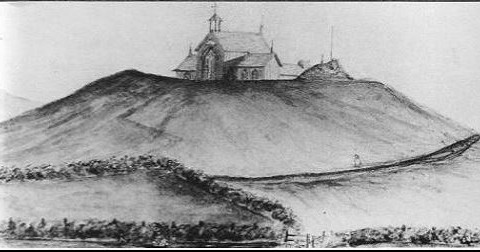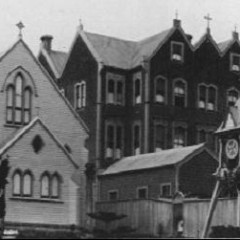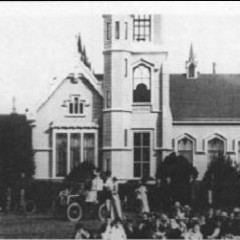6:2
would pay him for the land. He agreed. Next problem: How to cut it up? Here we found another victim of the slump, a contractor who had mortgaged his bulldozers and other implements, who agreed to do the job, and as we sold the sections we paid him for his work. This took some time, but we went ahead and when the whole estate was ready for the builders we had discharged all our obligations and emerged with several thousand dollars each. So, from absolutely nothing, I had become quite a prosperous young man for those days, with enough money to start-again-my career in road-making.' Matthews joined two men, Henry Isherwood and Bertie Bellam, who were both hospital victims of a car crash, and who had been laying bitumen (the first in Auckland) for the Fletcher Construction Company. But they were not good businessmen, and were losing money. Matthews was made foreman and he and his gang laid roads for the Ellerslie Town Board. A few months later Isherwood and Bellam offered him a partnership. His first tender was for the Egmont County, where he and his gang, over several years, did almost $200,000 worth of work. In 1939 he bought out his partners and carried on the business in his own name. He employed six gangs, each with steam-rollers, bitumen-laying machines and primitive bulldozers, and they sealed thousands of kilometres of roads in Invercargill, Whangarei, Hawke's Bay and Dunedin, as well as the main streets in Waitara and later in New Plymouth. He made several trips to Europe and America where he studied the latest methods of road-making, and soon he was regarded as perhaps the greatest authority on the subject in New Zealand. 'The Ministry of Works in Wellington often asked for my advice when they had a ticklish problem, and I was very glad to be able to help them,' he said. A career such as his was not without its complications. In the 1940s the firm was under contract to the Eketahuna County Council when a girl was slightly injured when her car slid off a newly-sealed road. A case was taken to the Supreme Court and judgment went against Matthews who was ordered to pay $2400 in damages, because the contract stated that the contractor would be responsible for any accident while work was being done. 'In those days I knew nothing about insurance, or public risk,' Matthews recalled. 'I paid up.' A few months later, to his amazement, he received a letter from the Highways Department, which had subsidised the job, explaining that it was felt in official circles that' Mr Matthews, who had done wonderful work in many parts of New Zealand' had been persecuted in the Eketahuna case. Enclosed was a cheque for $2000 in gratuitous payment. Later he received a cheque from the Eketahuna Council for $400, the balance of the claim. 'Many years afterwards I was staying at a hotel in Feilding when I met a man who had served on the jury in the case. I asked him why they had decided against me when the evidence clearly showed that my firm was blameless. He answered: "the jury thought you were insured." , Russell Matthews also had interests in several other New Plymouth companies in particular as founding director and chairman of directors ofIvon Watkins-Dow Ltd, serving on that Board from 1944 to 1962. In 1959 when he was 64, he sold up his road contracting business-part to a long standing employee Stan Riddick and the remainder to a former employee, Gerald Goudie. He retained the operation of a small bitumen business which supplied products to New Plymouth and surrounding areas. Following the joining of the company by his son, John Matthews, in 1962, expansion of varying activities occurred-Russell Matthews Industries Ltd in bitumen supply with a large bulk installation at Port Taranaki serving Taranaki, Wanganui and the King Country; Technic Industries Ltd in bitumen emulsion, asphaltic concrete and specialised bitumen products manufacture, Asphaltic Construction as a major roading contracting company in the country, Technic Properties and Technic Group as property development and holding companies, and Fitzroy Engineering in a wide range of engineering activities. There have been plenty of other enterprising men in the roading business in New Plymouth. Typical of many entrepreneurs was young John Franklyn Hooker, self-styled 'bullock conductor' who, at the age of 15, set up his own business, carting stones with his one-ox team. One of his first jobs was to carry gravel to improve the condition of the tracks which served as streets in the town. Today's users of Devon or Brougham Streets, with their smooth tar-sealing, travel over the same ground on which John Hooker once spread gravel from his huge- wheeled cart. John was born in 1853 in a cottage on the site of the present Devonport Flats, the son of Nathaniel Hooker, a stonemason. For a mason the little settlement was a busy and demanding place and Nathaniel found himself with plenty of work, which included helping to build the first section of St Mary's Church, and lining the stream banks along Devon Street in preparation for bridging work. In spite of his father's growing business, John considered New Plymouth a 'one-horse town' which held little for him. When he was 14he left forTe Namu, near Opunake, where he worked in a flax mill, saving enough money in a year to buy his ox and cart, with which he returned to New Plymouth in 1869. Two years later he 'officially' founded the firm of Hookers when he bought two horses and an 'express' wagon and established himself as a general carrier. He found it hard going in more senses than one: often he would earn no more than 10c a day. Among his earliest jobs was carting timber for the Waiongona and Mangaoraka bridges, north of New Plymouth, and picking up goods from the Waitara River which served as a port before New Plymouth's harbour was built. He also carted commercial travellers' stocks landed on the beach from surfboats-the surf was not always negotiable-off New Plymouth.
This was a risky business, but it was profitable, and in 1890John Hooker was able to build a large travellers' sample room on the corner of Egmont and King Streets. During the 1880s John and his two-horse express carted stones to soldiers stationed at Opunake during the Parihaka disturbances. This meant a gruelling journey of four days through swamps, roadless country, unbridged rivers and along the beach. With the establishment of the railway and the harbour, he built goods sheds on the site of the present Taranaki Producers' Freezing Co. store, and found himself almost fully occupied carting goods from there into the town. He charged 30c a tonne for haulage from the port into the town. In 1980 the charge for the same work is $4 a tonne. One of his horses, Jumbo, earned a reputation as 'the strongest horse of his size in New Zealand'. Jumbo could haul two tonnes of goods at a time, and for many years was a familiar sight on the road between the port and the town. Business increased, and by 1914, when John retired and handed over to his sons, Fred, Gordon, Royce and Edgar, he owned four 'expresses' and eight horses. The firm's name then became Hooker Brothers. Although by 1916 the first motor truck was acquired, horse-teams were in use as late as 1936. In 194022 men were employed; there was a fleet of 12 trucks, and the firm's slogan became' Anyware to Anywhere'. Royce Hooker, who had been managing director for 40 years, died in 1970 and his place was taken by Don Hooker, who had up till then been responsible for the firm's growing travel service. Activities included agencies for most shipping lines, haulage of all sorts using huge articulated vehicles and tiny 'snappy service' trucks. Hookers' house- hold removal pantechnicons have for many years been a familiar sight in many of New Zealand's cities and towns. In 1976 Hooker Bros Ltd merged with the New Zealand transport giant, the TNL group of Nelson, and early in 1978 Don Hooker retired. Thus, after 109 years, only the name and about one million dollars' worth of capital assets remained to remind citizens of a firm which grew up with the town.
The Taranaki County Council is one of the original 63 county councils constituted in 1876 on the abolition of the provincial government. Its area today is about 60,000 ha, and it embraces some of the most fertile land in New Zealand. The inaugural meeting was held in the Provincial Council chambers, New Plymouth, on January 4, 1877, 'pursuant to a summons from His Excellency Governor Normanby'* and the first minutes reveal that in common with the rest of the country progress was hampered by two continuing difficulties. The main one was shortage of money and this automatically gave rise to the second-the provision of suitable roads to the farms which were being developed. To help finance their construc- tion and maintenance, the Taranaki Provincial Council had passed a turnpike ordinance on June 30, 1868. Fees were: Horses 3c, carriages 5c, van or passenger conveyance 20c, bullock dray 2c, cattle 2c, pigs, sheep and goats half a cent per head. Eighteen months later an amendment added a similar fee for 'asses and mules".? New Plymouth's first toll-gate had been erected at Te Henui, near Watson Street, in 1870, and others were positioned at the junction of Ornata and South Roads (Whaler's Gate), the crossroads at Mangorei, Oakura, and at the Waiwakaiho river bridge. The Te Henui gate was the subject of great controversy and the services of the Premier were sought before it was resolved. The dues went into the coffers of the Provincial Council until it was abolished in 1876, and immediately dispute arose between the new Taranaki County Council and the New Plymouth Borough Council. Te Henui toll-gate was claimed by the county council to be illegal, because the Act stated that no gate should be sited 'within a mile of borough boundaries'. The matter was taken to the central government, which ruled in favour of the county council. The borough discovered the county intended moving the gate and its attendant building, and made it known it would resist. Whereon the county sent a bodyguard to protect its toll-gate. The four men were ordered 'not to provoke a breach of the peace'. The Mayor, Arthur Standish, promptly sent a posse of four of his men to 'forcibly prevent the county's contractors from proceeding' .10 There was stalemate; the county men withdrew, as did the borough council's detachment, and it seemed the crisis was over. But during the night of March 15 the tollkeeper was awakened by strange noises. He looked out and saw the contractor and eight men dismantling the gate and the posts from which it swung. Next morning, the Herald reported: 'Mayor Standish rode out to inspect the damage, and ordered a new gate to be erected.' For some weeks tolls continued to be collected at Te Henui by the borough council's men. But there was grumbling from the county councillors and eventually the Premier, Major Atkinson, discussed the controversy with both parties. On his recommendation the borough council removed the gate, and the county council erected its own at the Waiwakaiho Bridge. Until March 31, 1925, toll-gates collected revenue which enabled the county council to make roads, some of which were regarded by visitors as 'the finest in New Zealand'. Such was the success of this policy that in 1920, during one of the many conflicts of interest with the borough council, the county council threatened to 'ring New Plymouth with toll-gates' .


